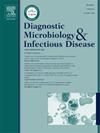尼帕病毒诊断试验:概况分析
IF 1.8
4区 医学
Q3 INFECTIOUS DISEASES
Diagnostic microbiology and infectious disease
Pub Date : 2025-09-06
DOI:10.1016/j.diagmicrobio.2025.117101
引用次数: 0
摘要
尼帕病毒是一种新出现的人类病原体,病死率很高。世界卫生组织2019年发布的尼帕病毒研发路线图强调,缺乏经过验证和监管的尼帕病毒诊断检测,特别是那些可在护理点使用的检测。该分析评估了NiV诊断的现状,包括商业测试和开发中的测试,以确定这些差距是否仍然存在。方法:通过检索诊断数据库和新闻平台、有针对性的互联网查询和与制造商的电子邮件交流,确定用于NiV诊断的商业检测。通过文献检索确定了非商业测试。包括分子测试、免疫分析和支持性方案,如适合现场的样品失活。结果:我们确定了43种商用NiV检测。只有六项测试获得了国家监管机构的批准。设计了三种接近POC的分子测试和一种真正POC的横向流动测试。通过文献检索确定了28篇出版物,其中23篇描述了测试开发和/或验证,3篇是独立评估或外部质量保证研究,2篇是NiV灭活方案。9份出版物报道了新型POC原型的开发,其中7份是分子分析,1份是抗原测试,1份是核酶生物传感器。这些原型的临床表现数据有限。结论:可获得的商业检测试剂盒很少,特别是适合在病毒流行的偏远地区使用的POC检测试剂盒。为了弥补这一差距,需要进一步评价和验证开发中具有POC潜力的测试。本文章由计算机程序翻译,如有差异,请以英文原文为准。
Diagnostic tests for Nipah virus: A landscape analysis
Introduction: Nipah virus (NiV) is an emerging human pathogen with a high case fatality rate. The World Health Organization research and development roadmap for NiV published in 2019 highlighted a lack of validated and regulated Nipah virus (NiV) diagnostic tests, particularly those that can be used at the point of care (POC). This analysis assessed the current landscape of NiV diagnostics, including commercial tests and tests in development, to determine whether these gaps remain.
Methods: Commercial tests for NiV diagnosis were identified through searches of diagnostic databases and news platforms, targeted internet queries, and email exchanges with manufacturers. Non-commercial tests were identified through a literature search. Molecular tests, immunoassays and supportive protocols such as field-appropriate sample inactivation were included.
Results: We identified 43 commercial NiV tests. Only six tests had national regulatory approval. Three molecular tests were designed for near POC and one lateral flow assay for true POC testing. Twenty-eight publications were identified by the literature search, of which 23 described test development and/or validation, three were independent evaluations or external quality assurance studies, and two were NiV inactivation protocols. Nine publications reported novel POC prototype development, of which seven were molecular assays, one an antigen test, and one a ribozyme biosensor. Clinical performance data on these prototypes were limited.
Conclusions: Few commercial tests for NiV are available, especially POC tests suitable for use in remote settings where the virus is endemic. To address this gap, further evaluation and validation of tests in development with POC potential is required.
求助全文
通过发布文献求助,成功后即可免费获取论文全文。
去求助
来源期刊
CiteScore
5.30
自引率
3.40%
发文量
149
审稿时长
56 days
期刊介绍:
Diagnostic Microbiology and Infectious Disease keeps you informed of the latest developments in clinical microbiology and the diagnosis and treatment of infectious diseases. Packed with rigorously peer-reviewed articles and studies in bacteriology, immunology, immunoserology, infectious diseases, mycology, parasitology, and virology, the journal examines new procedures, unusual cases, controversial issues, and important new literature. Diagnostic Microbiology and Infectious Disease distinguished independent editorial board, consisting of experts from many medical specialties, ensures you extensive and authoritative coverage.

 求助内容:
求助内容: 应助结果提醒方式:
应助结果提醒方式:


